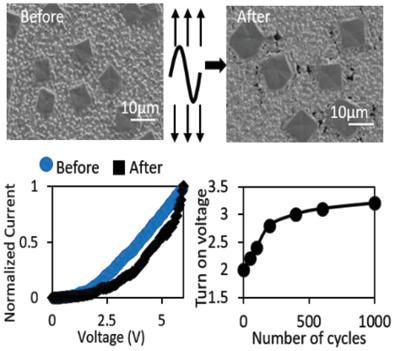当前位置:
X-MOL 学术
›
Macromol. Mater. Eng.
›
论文详情
Our official English website, www.x-mol.net, welcomes your feedback! (Note: you will need to create a separate account there.)
Failure Mechanisms of Stretchable Perovskite Light-Emitting Devices under Monotonic and Cyclic Deformations
Macromolecular Materials and Engineering ( IF 3.9 ) Pub Date : 2021-09-12 , DOI: 10.1002/mame.202100435 Sharafadeen Adeniji 1, 2, 3 , Oluwaseun Oyewole 1, 4 , Richard Koech 1, 5 , Deborah Oyewole 1, 4, 6 , Jaya Cromwell 1 , Ridwan Ahmed 1, 4 , Omolara Oyelade 2 , Dahiru Sanni 2 , Kingsley Orisekeh 5 , Abdulhakeem Bello 2, 5 , Winston Soboyejo 1, 4, 7
Macromolecular Materials and Engineering ( IF 3.9 ) Pub Date : 2021-09-12 , DOI: 10.1002/mame.202100435 Sharafadeen Adeniji 1, 2, 3 , Oluwaseun Oyewole 1, 4 , Richard Koech 1, 5 , Deborah Oyewole 1, 4, 6 , Jaya Cromwell 1 , Ridwan Ahmed 1, 4 , Omolara Oyelade 2 , Dahiru Sanni 2 , Kingsley Orisekeh 5 , Abdulhakeem Bello 2, 5 , Winston Soboyejo 1, 4, 7
Affiliation

|
This paper presents the results of experimental and analytical studies of the failure mechanisms of stretchable perovskite light-emitting devices (PeLEDs). The multilayered PeLED structures consist of an anodic layer of poly(3,4-ethylenedioxythiophene):polystyrene-sulfonate (PEDOT:PSS), an emissive layer of methylammonium lead bromide (MAPbBr3), and a eutectic gallium–indium (EGaIn) cathodic layer, which are deposited onto treated polydimethylsiloxane substrates. The intrinsically nonstretchable MAPbBr3 and PEDOT:PSS are modified with poly(ethylene oxide). The failure mechanisms of the layered stretchable PeLED structures are then investigated under monotonic and cyclic deformations. The optical and scanning electron microscopy images show the deflection and propagation of cracks and wrinkles under applied strains. Cracking of perovskite crystal and debonding of films are also observed with increased cyclic deformation. The effects of the failure mechanisms on the optoelectronic properties of the devices are then studied. The in situ measured transmittance of the PEDOT:PSS (≈75%) reduces with increasing uniaxial strain, and then is increased close to its initial value when the strain is released. The turn-on voltage of the device increases with increasing number of cycles between 50 and 1000 cycles at 20% strain level. The fatigue lifetimes of the PeLED structures are used to explain the design of stretchable perovskite devices.
中文翻译:

单调和循环变形下可拉伸钙钛矿发光器件的失效机制
本文介绍了可拉伸钙钛矿发光器件 (PeLED) 失效机制的实验和分析研究结果。多层 PeLED 结构由聚(3,4-亚乙基二氧噻吩):聚苯乙烯-磺酸盐(PEDOT:PSS)阳极层、甲基溴化铅(MAPbBr 3)发射层和共晶镓铟(EGaIn)阴极层组成。层,沉积在处理过的聚二甲基硅氧烷基材上。本质上不可拉伸的 MAPbBr 3和 PEDOT:PSS 用聚(环氧乙烷)改性。然后在单调和循环变形下研究分层可拉伸 PeLED 结构的失效机制。光学和扫描电子显微镜图像显示了在施加的应变下裂纹和皱纹的偏转和扩展。随着循环变形的增加,钙钛矿晶体的开裂和薄膜的剥离也被观察到。然后研究了失效机制对器件光电特性的影响。PEDOT:PSS (≈75%) 的原位测量透射率随着单轴应变的增加而降低,然后在应变释放时增加到接近其初始值。在 20% 应变水平下,器件的开启电压随着 50 到 1000 次循环之间的循环次数的增加而增加。
更新日期:2021-11-15
中文翻译:

单调和循环变形下可拉伸钙钛矿发光器件的失效机制
本文介绍了可拉伸钙钛矿发光器件 (PeLED) 失效机制的实验和分析研究结果。多层 PeLED 结构由聚(3,4-亚乙基二氧噻吩):聚苯乙烯-磺酸盐(PEDOT:PSS)阳极层、甲基溴化铅(MAPbBr 3)发射层和共晶镓铟(EGaIn)阴极层组成。层,沉积在处理过的聚二甲基硅氧烷基材上。本质上不可拉伸的 MAPbBr 3和 PEDOT:PSS 用聚(环氧乙烷)改性。然后在单调和循环变形下研究分层可拉伸 PeLED 结构的失效机制。光学和扫描电子显微镜图像显示了在施加的应变下裂纹和皱纹的偏转和扩展。随着循环变形的增加,钙钛矿晶体的开裂和薄膜的剥离也被观察到。然后研究了失效机制对器件光电特性的影响。PEDOT:PSS (≈75%) 的原位测量透射率随着单轴应变的增加而降低,然后在应变释放时增加到接近其初始值。在 20% 应变水平下,器件的开启电压随着 50 到 1000 次循环之间的循环次数的增加而增加。



























 京公网安备 11010802027423号
京公网安备 11010802027423号